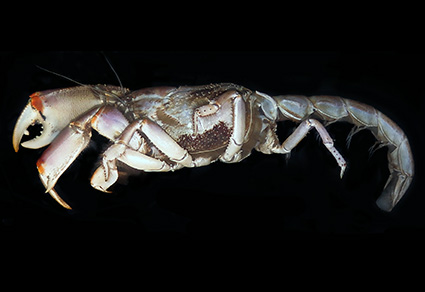Abstract
A new species of mud lobster of the genus Thalassina Latreille, 1806 (Decapoda: Gebiidea: Thalassinidae), Thalassina cangioensis sp. nov., is described from mangrove forests of the Cần Giờ Mangrove Biosphere Reserve, located in the Soài Rạp River delta in the downstream of the Dongnai-Saigon River system, South Vietnam. The new species is morphologically mostly similar to T. anomala (Herbst, 1804) in the shape of the rostrum and anterior part of the carapace and the presence of a single median tubercle on pleonal sternites II–V. However, it differs in the strong spinulation on the posterior part of the carapace, the armature of the pereopods I (chelipeds), and the presence of spines on the proximal part of the pleopod I in males. The shape of the pleopod I in males of the new species is mostly similar to that of T. squamifera, but it can be distinguished by the downwardly bulging median part at the tip, which is unique to the genus. Molecular genetic analysis revealed that the new species strongly genetically diverged (by the mitochondrial COI gene marker) from all currently sequenced species of the genus Thalassina, such as T. anomala, T. gracilis, T. kelanang and T. squamifera.
References
- Albarico, F.P.J., Gacutan, R. & Bedi, A.M. (2020) First record of Thalassina kelanang (Crustacea: Decapoda: Thalassinidae) from the Philippines. The Palawan Scientist, 12, 61–67.
- Avise, J.C. (1994) Molecular markers, natural history and evolution. Chapman and Hall, New York, 511 pp. https://doi.org/10.1007/978-1-4615-2381-9
- Bedi, A.M.B. & Primavera, J.H. (2018) New record of Thalassina spinosa (Crustacea: Decapoda: Gebiidea: Thalassinidae) from the Philippines. Philippine Journal of Science, 147 (3), 357–361.
- Bell, T. (1845) On the Thalassina emerii, a fossil crustacean, forwarded by Mr. WS MacLeay, from New Holland. Quarterly Journal of the Geological Society, 1 (1), 93–94. https://doi.org/10.1144/GSL.JGS.1845.001.01.23
- Dana, J.D. (1852) Conspectus crustaceorum, etc., Conspectus of the Crustacea of the Exploring Expedition under Capt. Wilkes, USN, including the Paguridea, continued, the Megalopidea, and the Macroura. Paguridea, continued, and subtribe Megalopidea. Proceedings of the Academy of Natural Sciences, Philadelphia, 6, 6–28.
- De Man, J.G. (1915) Zur Fauna von Nord-Neuguinea. Nach den Sammlungen von Dr. PN van Kampen und K. Gjellerup in den Jahren 1910–1911. Macrura. Zoologisches Jahrbücher Abtheilung für Systematik, 38, 385–458.
- Dubey, S.K., Choudhury, A., Chand, B.K. & Trivedi, R. (2012) Ecobiological study on burrowing mud lobster Thalassina anomala (Herbst, 1804) (Decapoda: Thalassinidea) in the intertidal mangrove mudflat of deltaic Sundarban. Exploratory Animal and Medical Research, 2 (1), 70–75.
- Folmer, O., Black, M., Hoeh, W., Lutz, R. & Vrijenhoek, R. (1994) DNA primers for amplification of mitochondrial cytochrome c oxidase subunit 1 from diverse metazoan. Molecular Marine Biology and Biotechnology, 3, 294–299.
- Guindon, S., Dufayard, J.F., Lefort, V., Anisimova, M., Hordijk, W. & Gascuel, O. (2010) New Algorithms and Methods to Estimate Maximum-Likelihood Phylogenies: Assessing the Performance of PhyML 3.0. Systematic Biology, 59, 307–321. https://doi.org/10.1093/sysbio/syq010
- Hassan, M., Lian, C.J., Zakariah, M.I. & Azmi, M. (2015) A first report on mudlobster (Thalassina anomala) and its mound characteristics from Setiu wetland, Terengganu, Malaysia. Journal of Sustainability Science and Management, 10 (2), 112–116.
- Hebert, P.D., Ratnasingham, S. & de Waard, J.R. (2003) Barcoding animal life: cytochrome c oxidase subunit 1 divergences among closely related species. Proceedings of the Royal Society of London, Series B, 270 (Supplement 1), S96–S99. https://doi.org/10.1098/rsbl.2003.0025
- Herbst, J.F.W. (1804) Versuch einer Naturgeschichte der Krabben und Krebse: nebst einer systematischen Beschreibung ihrer verschiedenen Arten. Gottlieb August Lange, Berlin und Stralsund, 49 pp.
- Hess, W. (1865) Beiträge zur Kenntniss der Decapoden-Krebse ost-Australiens. Archiv für Naturgeschichte, 31, 127–173. https://doi.org/10.5962/bhl.part.15862
- Hossain, M.S., Bujang, J.S., Kamal, A.H.M, Harah, M.Z. & Muslim, A.M. (2019) Behavioural response of the mud lobster, Thalassina anomala Herbst, 1804 (Decapoda, Gebiidea), to different trapping devices. Crustaceana, 92 (3), 353–371. https://doi.org/10.1163/15685403-00003869
- Johnson, D.S. (1961) The food and feeding of the mud-lobster, Thalassina anomala (Herbst). Crustaceana, 2 (4), 325–326. https://doi.org/10.1163/156854061X00455
- Kimura, M. (1980) A simple method for estimating evolutionary rates of base substitutions through comparative studies of nucleotide sequences. Journal of Molecular Evolution, 16, 111–120. https://doi.org/10.1007/BF01731581
- Kumar, S., Stecher, G. & Tamura, K. (2016) MEGA7: molecular evolutionary genetics analysis version 7.0 for bigger datasets. Molecular Biology and Evolution, 33 (7), 1870–1874. https://doi.org/10.1093/molbev/msw054
- Latreille, P.A. (1807) Genera crustaceorum et insectorum secundum ordinem naturalem in familias disposita: iconibus exemplisque plurimis explicate. Vol. 3. A. Koenig, Parisiis, 399 pp. https://doi.org/10.5962/bhl.title.34916
- Lin, F.J., Komai, T. & Chan, T.Y. (2016) A new mud lobster of the genus Thalassina Latreille, 1806 (Crustacea: Decapoda: Gebiidea: Thalassinidae) from marine seagrass beds in Dongsha (Pratas) Island, South China Sea. Raffles Bulletin of Zoology, 64, 98–104.
- Moh, H.H., Chong, V.C., Lim, P.E., Tan, J. & Dally, G. (2013) Verification of four species of the mud lobster genus Thalassina (Crustacea: Decapoda: Gebiidea: Thalassinidae) using molecular and morphological characters. Raffles Bulletin of Zoology, 61 (2), 579–588.
- Moh, H.H., Chong, V.C. & Sasekumar, A. (2015) A. Distribution and burrow morphology of three sympatric species of Thalassina mud lobsters in relation to environmental parameters on a Malayan mangrove shore. Journal of Sea Research, 95, 75–83. https://doi.org/10.1016/j.seares.2014.10.006
- Moh, H.H. & Chong, V.C. (2009) A new species of Thalassina (Crustacea: Decapoda: Thalassinidae) from Malaysia. Raffles Bulletin of Zoology, 57 (2), 465–473.
- Ngoc-Ho, N. & de Saint Laurent, M. (2009) The genus Thalassina Latreille, 1806 (Crustacea: Thalassinidea: Thalassinidae). Raffles Bulletin of Zoology, 20, 121–158.
- Ngokoed, N. & Ratmuangkhwang, S. (2020) Some biological aspects of mud lobsters, Thalassina spp. In: Kampuan mangrove forest, Ranong province. Andaman Coastal research Station for Development. Faculty of Fisheries, Kasetsart University, Bangkok, 76 pp.
- Sakai, K. & Türkay, M. (2012) A review of the species of the genus Thalassina (Thalassinidea, Thalassinidae). Crustaceana, 85 (11), 1339–1376. https://doi.org/10.1163/15685403-00003114


